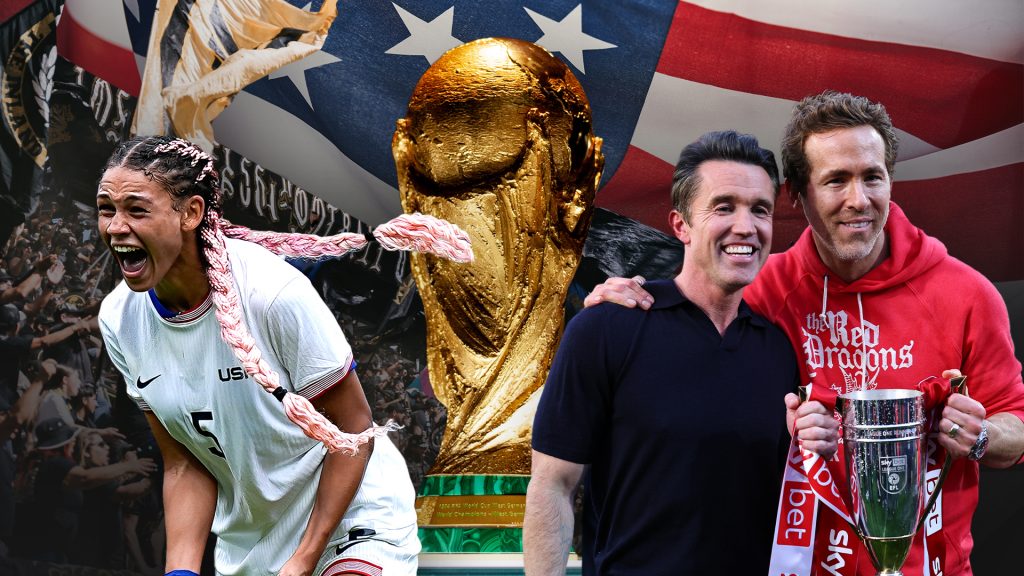Underdog no more, how soccer is surging in US less than a year from World Cup

Americans’ interest in soccer is reaching an all-time high as the World Cup draws near. A new study by Harris Poll found that up to 75% of Americans are interested in soccer, a 17% increase since 2020.
With 6.5 million people expected to attend the 2026 World Cup, fans, businesses and soccer officials expect next year’s tournament to be transformative. Experts and fans told Straight Arrow News that soccer’s growing popularity can be attributed to everything from the growth of immigrant communities to new TV deals expanding game accessibility, even to viewers being introduced to Ted Lasso.
Jason Takhtadjian, a Fresno-based news anchor, grew up playing soccer. As an adult, and a diehard Chelsea fan since the mid-2000s, he’s spent years waking up early to catch games at 5 a.m. before services like Peacock were around to carry Premier League games. He was excited to see stars such as Didier Drogba and Frank Lampard win titles and fight for a common cause.
How popular is the World Cup in America?
“The sport has become more accessible, and we have gotten to know what people are saying around the world,” Takhtadjian told Straight Arrow News. “Broadcasts from CBS Golazo and Peacock have put it in people’s faces. As long as the sport is accessible to the fans, the game will expand.”
America hosted the World Cup once before in 1994, an event that helped launch Major League Soccer (MLS) and the U.S. Soccer Foundation, and laid the groundwork for the sport’s future in the States.
Melanie McAninch, a Memphis-based pharmacist, told Straight Arrow News that serving as president of her city’s local chapter of the nonprofit soccer-boosting organization American Outlaws “consumes (her) entire life.”
Her love of the sport started when she watched the 2006 World Cup with her late French grandmother, and it grew further as she watched the women’s team win World Cups over the years.
“I have been to two Women’s World Cups and definitely plan to go to the next one in Brazil,” she said. “Almost all of my vacations are soccer-related. It’s a huge part of my life.”
The World Cup is a massive marketing moment for the sport, not to mention an economic engine. And investors and soccer officials have taken note. In a sport where sponsor logos are bigger than the team crest, soccer teams have been synonymous with brands and commercial appeal.
FIFA President Gianni Infantino said the 2025 Club World Cup generated more than $2 billion, making it the most financially successful iteration of the tournament in its history.

What’s with all the celebrities buying soccer teams?
Many American investors have begun purchasing stakes, or even outright ownership, in teams throughout the world, including Manchester United, Liverpool and Arsenal, among others. At least two MLS teams, Inter Miami and Los Angeles FC (LAFC), are now worth $1 billion, according to Forbes. Comedian Will Ferrell is a part-owner of the latter.
He joins other celebrities like Tom Brady, who recently invested in English soccer club Birmingham City, Kevin Durant, who owns a stake in Paris Saint-Germain and Michael B. Jordan, who is a minority owner in the English Premier League team AFC Bournemouth. Some of these big names turn their teams into big brands.
On the heels of the American success of Ted Lasso, which helped give Americans a glimpse into soccer culture, actors Ryan Reynolds and Rob McElhenney launched their docuseries, “Welcome to Wrexham,” about the Welsh soccer club they co-own.
With more than 30 MLS teams and a 10-year, $2.5 billion broadcast deal with Apple TV, soccer’s U.S. footprint is poised to grow even further. Most importantly, it presents an opportunity for what was once seen as a niche sport to enter the popular consciousness.
Unbiased. Straight Facts.TM
U.S. men’s soccer had its best Olympic showing in 2000, when the team reached fourth place at the Sydney Olympics. Women’s soccer has won five gold medals in 1996, 2004, 2008, 2012 and 2024.

“Next year’s World Cup offers a transformational opportunity,” said Brian Katzowitz, a spokesperson for the U.S. Soccer Federation. “This is about making 2026 not just a tournament, but a catalyst for lasting change across all three host nations.”
According to the Harris study, 65% of soccer fans still think of soccer as a foreign sport. But that’s not necessarily a deterrent.
Cameron Kirkpatrick, who lives in Saugerties, New York, follows the Premier League giants Manchester United, the Seattle Sounders and other lower-league German teams.
“So many people write off soccer for being a European concept, but I have to say that it’s not anything awful,” Kirkpatrick told Straight Arrow News. “I love the people I come with to watch it with. It doesn’t need to be something you care about every four years.”
What keeps fans from attending soccer games in the US?
Still, the international appeal leaves many fans with questions about both affordability and safety. With a large Hispanic fanbase and foreigners traveling for matches, the recent increase in ICE raids has concerned fans at home and abroad over how fans will be treated during matches.
Although FIFA controls which cities host World Cup matches, President Donald Trump has threatened to lobby the organization to move certain matches out of areas like Boston. Vice President JD Vance has said ICE will be ready to detain individuals if possible.
McAninch said she plans to attend a World Cup match next year. But she is worried about the possibility of violence and disorder caused by federal immigration agents during the tournament.
“I do worry about the implications of Trump’s policies for people who do live here and are visiting,” she said. “I’ve had many mixed feelings about the World Cup, but I’m going to try to avoid those feelings. I do not want anyone to take away joy from me.”
Is soccer an expensive sport?
Immigration is not the only concern that could keep fans from the stands next year. After backlash over dramatically high ticket prices for the Club World Cup, FIFA has given greater consideration to using dynamic pricing for cheaper World Cup tickets. ESPN reported that prices could range from $60 for group stage matches to $6,730 for the final.
And it’s not just watching the sport that can break the bank. The cost of playing soccer has drawn plenty of criticism over the years, as Americans’ level of access to youth soccer lags behind other nations, particularly among Black and Hispanic children. Soccer is among the nation’s most expensive sports to play, costing roughly $1,188 per child annually.
This higher cost of entry has a real impact. Many critics of the “pay-to-play” model state that the United States lags in men’s development in the sport because of the higher cost of entry, which turns away immigrant communities and people of color.
“Six hundred bucks for year-round club play doesn’t sound like a lot, but it was definitely unaffordable for my family growing up nearly 20 years ago,” Takhtadjian said.
How can soccer become more affordable?
Organized soccer is aware of this. Katzowitz, from the U.S. Soccer Federation, said his organization expects the World Cup tournament to serve as a massive catalyst to expand youth participation.
“We’re partnering more closely with community organizations, local leaders and youth clubs to invest in coaching, player development and low-cost or no-cost opportunities that keep kids in the game longer,” Katzowitz explained.
The Soccer Forward Foundation will rally support for more youth development by building new fields, strengthening local clubs and ensuring that all American kids live within 15 minutes of a field to play in.
As part of this philosophy, community leaders in cities like Chicago partnered with the Chicago Fire to establish places like the North Austin Center on Chicago’s West Side. The new state-of-the-art sports facility offers 20 hours a week of free community soccer programs in a predominantly Black community.
Kids can grow the sport. And female fans, and athletes, are also doing their part: Nearly a third of soccer fans are women, thanks in large part to the success of the women’s national team and the National Women’s Soccer League (NWSL), which has helped the game grow even as the men’s national team lagged behind.
“The work the team did for equal pay was incredible and opened the door for so many women after them,” McAninch said. “They are making sure they make things better for the next generation, they’re not just pulling the ladder from under them.”
The women’s national team is the most successful women’s team of all time, winning four World Cup titles and five Olympic gold medals. Women like Michele Kang have pledged $30 million over the next five years to growing the women’s game.
Representatives from the U.S. Soccer Federation confirmed to Straight Arrow News that they are lobbying to host the 2031 Women’s World Cup in the United States.
While no one knows for sure how the tournament will play out, the group believes that 2026 will be the most transformative year for the sport.
“U.S. Soccer stands at the cusp of a tremendous opportunity. The passion and interest we’re seeing across the country, especially from younger and more diverse fans, point to a future where soccer plays a bigger role in American culture,” Katzowitz said.
The post Underdog no more, how soccer is surging in US less than a year from World Cup appeared first on Straight Arrow News.





